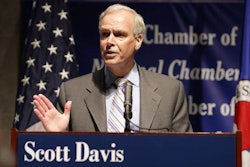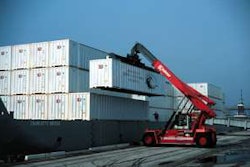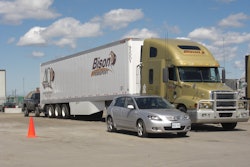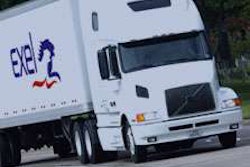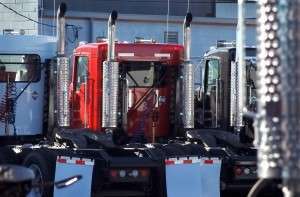
At a hearing on Monday, Nov. 15, on a proposal to establish first-ever fuel economy rules for commercial and work trucks and engines, the chairman of the American Truck Dealers urged federal regulators to ensure that any new mandates are “appropriate, cost-effective and technologically feasible.” Kyle Treadway, ATD chairman, highlighted the significance of Section 102 of the Energy Independence and Security Act of 2007, which requires that the National Highway Traffic Safety Administration determine whether to issue the fuel economy rules.
“First, any new fuel economy regulations must meet the statute’s requirement that [fuel economy rules] be ‘appropriate, cost-effective and technologically feasible,’ ” Treadway said in testimony at a joint NHTSA and U.S. Environmental Protection Agency hearing in Chicago, adding that if these three criteria are not met, “prospective customers will not purchase new vehicles and engines, reducing sales and leaving stock vehicles languishing on dealer lots.”
“Second, Congress vested NHTSA with the exclusive authority to regulate the fuel economy of these vehicles and engines by amending the Energy Policy and Conservation Act,” he added. “In doing so, Congress was cognizant of the EPCA’s prohibition against the adoption or enforcement of state laws related to fuel economy. This prohibition of any patchwork of state laws related to fuel economy is critical to dealers like me who sell new vehicles in several states, yet is even more important to our customers, such as for-hire carriers, private companies, public fleets and owner-operators who purchase trucks and engines in every state in the nation.”
Treadway stressed that even though EISA requires NHTSA to consult with the U.S. Department of Energy and EPA on fuel economy issues for commercial trucks and engines, Congress did not specifically authorize DOE or EPA to regulate concurrently with NHTSA. “ATD objects to all provisions in the proposal that would create enforceable EPA mandates, except for those potentially addressing air conditioning refrigerants,” he said.
Treadway noted that if fuel economy mandates for new trucks allow for duplicative nonidentical state rules, it “would impose an untenable burden on the R&D resources, the manufacturing processes and the marketing and distribution systems of new truck and engine manufacturers,” and “…ordering and stocking nightmares for dealers and their customers. … Our bottom line: Federal law does not permit a patchwork of state fuel economy-related mandates. ATD supports one national fuel economy standard for new trucks and engines.”
Treadway said in order for the proposed fuel economy mandates for MYs 2014-2018 to work, they must pass economic muster with truck and engine buyers. “My customers have options,” he said. “Instead of choosing to buy new fuel-efficient vehicles, they can instead pay my service and parts operations to help them keep their existing vehicles on the road, up to and including rebuilding engines or vehicles.” Treadway added that “cost is always a concern” and that his customers can buy used vehicles at a lower cost than new federally compliant ones. “That is why new fuel economy mandates must be affordable in order to have any chance at success in the marketplace.”
“Some of the nation’s largest fleets can afford to be ‘early adopters’ and to experiment with new fuels and technologies, even when they cost significantly more,” he said. “However, the vast majority of prospective new truck buyers … rationally consider the upfront cost of vehicle features, especially during times when credit is relatively tight and/or freight rates and profit margins are relatively low.”
Treadway also cautioned that fuel economy mandates should never compromise or even appear to compromise performance, which occurred when emissions mandates took effect in 2002, 2007 and 2010, resulting in economic disruptions in the marketplace. “Before my customers lay out the substantial investments necessary to purchase new vehicles, they want to be assured that they won’t be buying performance compromises, such as a decrease in freight hauling capability or an increase in maintenance and repair,” he said. “Especially with engines and other drivetrain components, improving one metric, such as fuel economy, must not diminish other critical performances metrics or result in higher vehicle costs. Otherwise, fuel-efficiency improvements won’t get bought and will fail in the marketplace.”
Cummins used Monday’s public hearing to further confirm its support for the standards. “While we are still working through the details of the proposal and are preparing written comments on specific aspects, we support the timeline laid out by President Barack Obama to finalize this rule by July 30, 2011, and deliver improvements over the 2014-to-2018 timeframe,” said Dr. Stephen Charlton, vice president and Engine Business chief technical officer. “The rule and these benefits can be delivered in this short timeframe because many of the building blocks already exist.
Charlton said that under the Clean Air Act, heavy-duty diesel engine emissions of nitrogen oxides (NOx) and particulate matter (PM) have been reduced by 99 percent, and DOE has fostered public-private partnerships to develop the heavy-duty technologies needed to meet stringent emissions standards and improve efficiency. Additionally, the SmartWay partnership, launched by the EPA in 2004, has attracted thousands of partners focused on reducing greenhouse gas emissions and fuel consumption.
“Cummins partnership with the DOE over the past 20 years has allowed us to bring evolutionary and breakthrough engine technologies to the market faster and at a lower cost than we could have done going it alone,” Charlton said. “Complying with the stringent 2010 NOx limits under the EPA’s Heavy-Duty Highway Rule has put Cummins well along the path of meeting future greenhouse gas and fuel-efficiency requirements.”
The EPA and NHTSA proposal establishes three regulatory categories of heavy-duty vehicles: (1) combination tractors; (2) heavy-duty pickup trucks and vans; and (3) vocational vehicles. For combination tractors and vocational vehicles, the agencies have proposed separate engine and vehicle standards. “We strongly support this regulatory structure,” Charlton said. “By building on our long history of working together, and by utilizing existing programs where possible, we can together deliver the greenhouse gas and fuel-consumption benefits envisioned in this rulemaking. We appreciate the open and collaborative process that the EPA and NHTSA have used in proposing this historic regulation. We look forward to continuing to work with the agencies over the coming months to develop a final rule.”
Speaking on behalf of the American Trucking Associations and the Illinois Trucking Association, ITA Associate Director Randy Thomas said the trucking industry is “pleased to see that the rules address four of ATA’s six proactive recommendations for reducing the trucking industry’s carbon footprint contained in its 2008 Sustainability Plan – namely reducing GHG’s and improving fuel efficiency by reducing and governing truck speeds; decreasing idling; implementing national fuel efficiency standards for medium- and heavy-duty trucks that are both economically and technologically feasible; and using off-the-shelf technologies to increase fuel efficiency verified by EPA under its GHG reduction program known as SmartWay.”
“Our industry has endorsed and participated whole-heartedly in EPA’s SmartWay program since its inception in 2004,” Thomas said. “With over 2,800 total partners driving over 650,000 trucks traveling over 60 billion miles per year, SmartWay partners have saved over 15 million metric tons of CO2, 1.5 billion gallons of diesel fuel and over $3.5 billion in fuel costs since 2004. We stand ready to continue our work with EPA to ensure further expansion and success of the SmartWay program.”
Thomas said that some fleets, while supportive of the proposed rules, have expressed concern that manufacturers might discontinue sales of specific engine or vehicle subcategories that fleets are accustomed to purchasing, instead of using any of the four “flexibility” approaches outlined in the proposal to assist OEMs in achieving their overall GHG and fuel efficiency targets.
“Trucks deemed ‘less efficient’ may no longer be offered for sale to purchasers that spec such equipment for their particular needs,” Thomas said. “The trucking industry supports the proposed rules and, like EPA and NHTSA, wants to ensure the avoidance of ‘unintended consequences’ under the rules. One issue of concern raised by some fleets revolves around the possible increased braking distances associated with certain fuel-efficient tires, particularly on rainy or icy pavement. We trust that both agencies will explore these two areas of concern further to ensure we avoid any such unintended consequences.”



